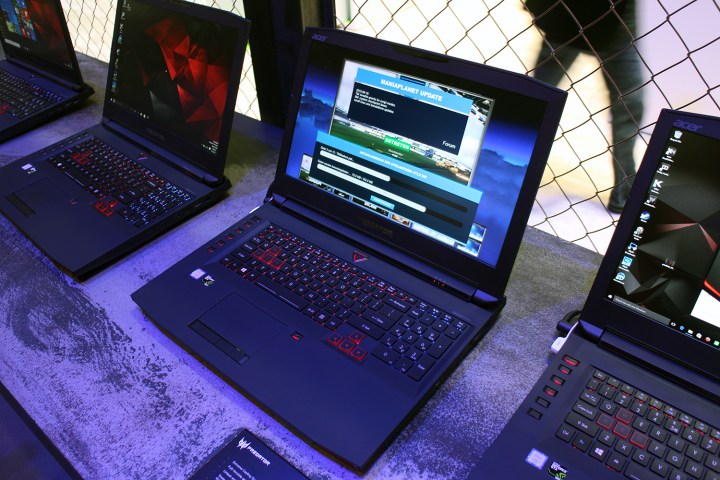
Long live PC gaming
Europeans are strong supporters of PC gamers, and Germany, the host of IFA, is a center of particularly strong support, with some surveys suggesting three-quarters of all gamers play on PCs. Acer, Asus, and Lenovo all brought professional gamers on stage to talk up their products and seized on the computer’s popularity as a chance to introduce new hardware. Asus introduced the G752 and GX700, Acer revealed new Predator hardware for both desktop and mobile, and Lenovo introduced a dedicated gaming laptop along with an all-new, high-end tower.
Competition in the gaming space is high, and most of the major manufacturers brought their best to the show.
These new systems are of course packing Intel’s sixth-generation Core processors. Intel’s release of the full lineup for both desktop and laptop has made IFA 2015 the perfect opportunity to debut new hardware, including overclockable laptops – though the details of those systems are still shrouded in mystery.
New processors are just the beginning of the story, however. Competition in the gaming space is high, and most of the major manufacturers brought their best to the show. Just a few years ago, the average gaming system – desktop or laptop – was powerful but also a bit flimsy. Chintzy plastics and colored LEDs dominated the field.
Today, gaming systems are engineering masterpieces. They combine hardware that’s several times more powerful than a “mainstream” computer with sleek aesthetics and tolerable prices. In short, a gaming computer represents the best consumer computing has to offer, and the new models shown at IFA 2015 look particularly promising.
UltraHD is taking over notebooks
Earlier this year I said 2015 would be the year of the monitor, and I think that’s proven true. 4K displays are now widely available and, at least in some cases, are fairly inexpensive. G-Sync and FreeSync enjoy wider support than ever before, with the former coming to laptops, and displays boasting a refresh rate above 60Hz are more common than ever before.
IFA 2015 makes it clear this trend is extending to notebooks. While 4K is certainly a premium feature, it is optional on almost all the gaming and premium notebooks introduced this year. That includes the Acer Predator 17, Asus G752, and Toshiba Satellite Radius 12. Those that don’t opt for
This surge in resolution has been building for some time, but it was held back by two problems. Windows 8.1 didn’t look great on pixel-dense displays, and most integrated graphics solutions didn’t support 4K. Now those restrictions have lifted. Windows 10 looks great even on the Toshiba Radius 12, which boasts 352 pixels per inch, and Intel’s new 6th-gen Core processors ship with integrated solutions that support
Unlike some other recent trends in consumer electronics, 4K and other pixel-dense resolutions are far more than a fad. They provide an immediately noticeable benefit for the user, and in some situations offer better use of limited display space. You can bet the offers at IFA 2015 are just the tip of the spear, and that we’ll see their numbers multiply rapidly at CES 2016 and throughout the coming year.
The 2-in-1 is out of ideas
While most of what I saw at IFA 2015 was positive, one trend did prove a bit of a downer. That’s the 2-in-1, also known as the convertible or hybrid device. There were plenty to be seen at the conference, but manufacturers still aren’t quite sure what to do with the concept.
Most of the new models shown used the same, tired, 360-degree hinge. First introduced by Lenovo in the original Yoga, it’s a concept that makes some sense in inexpensive convertibles designed for only occasional tablet use. In most cases, however, the design poorly imitates a “real” tablet because it doesn’t address a laptop’s excessive bulk and weight. The new Toshiba Satellite Radius 12 and Lenovo ThinkPad Yoga 260 are arguably the highlight 2-in-1 designs of IFA 2015, but both weigh 2.9 pounds — over three times more than the iPad Air 2.
The main alternative to a 360-degree hinge is the dockable. Designs of this type treat the keyboard as a removable dock, so they’re much lighter when used as a tablet alone – the best are around a pound and a half. We saw a few examples of this at IFA 2015, like the Lenovo Ideapad Miix 700 and Toshiba Click 10. Unfortunately, the pounds these systems shed are often offset by poor keyboard quality and more limited hardware. Neither of these new choices are an exception.

Even Intel doesn’t seem to have much to say on the subject. While it showed a new reference design at IDF 2015, the mock-up wasn’t shown at its IFA 2015 conference. Instead, the company’s connectivity demos focused on features like wireless display (WiDi) and wireless charging.
What 2-in-1s really need to succeed is a design that’s far thinner and lighter, yet doesn’t sacrifice battery life. The 6th-generation Core processor, while efficient, doesn’t move the needle far enough to make 2-in-1s viable for most buyers. How long will it be until we see a truly must-have convertible? I frankly have no idea – and I’m starting to wonder if the answer is “never.”
Evolution, not revolution
IFA 2015 reaffirms evolution as the driving trend in computers. The term “game changing,” always suspect, couldn’t be more useless for describing PCs. Most models sold today are just better incarnations of what was solid a few years ago.
Yet the lack of revolution has been replaced by a staggering pace of evolution. Several companies at the event, including Intel, made a point to highlight how today’s laptop compares to one sold five years ago. The two perform the same tasks, but the new model is several times quicker, lasts several times longer on a charge, offers two to four times greater pixel density, and likely costs less. IFA 2015 is just the latest in the computer’s march of progress, the pace of which seems to grow quicker with each year.


